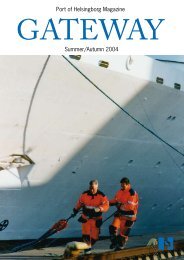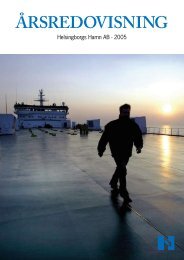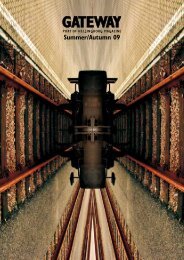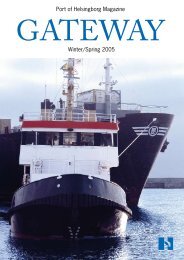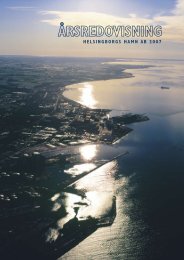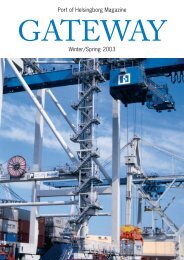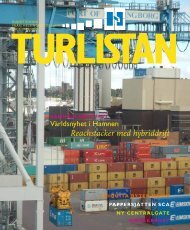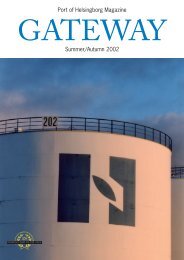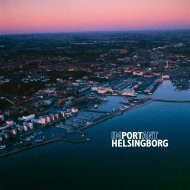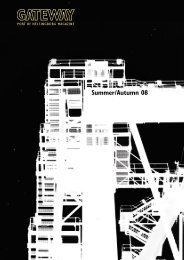Port of Helsingborg Magazine Winter/Spring 2006 - Helsingborgs ...
Port of Helsingborg Magazine Winter/Spring 2006 - Helsingborgs ...
Port of Helsingborg Magazine Winter/Spring 2006 - Helsingborgs ...
Create successful ePaper yourself
Turn your PDF publications into a flip-book with our unique Google optimized e-Paper software.
<strong>Port</strong> <strong>of</strong> <strong>Helsingborg</strong> <strong>Magazine</strong>GATEWAY<strong>Winter</strong>/<strong>Spring</strong> <strong>2006</strong>1
“Agila” calls at the West HarbourNew link with EnglandThe Transatlantic EuropeanServices AB shipping companyhas chosen to back<strong>Helsingborg</strong> with its trafficfor England calling here fourtimes a week. This means asubstantial increase in thenumber <strong>of</strong> calls made bycontainer ships at the <strong>Port</strong> <strong>of</strong><strong>Helsingborg</strong>.‘We reckon on initially turning overabout 200 units a week in <strong>Helsingborg</strong>,’says Stefan Lindgren, line managerat Transatlantic. The vessels “Frej”,“Odin”, “Heike” and “Agila” follow aroute between Södertälje, Västerås,Oxelösund, <strong>Helsingborg</strong> and Goole onthe north-east coast <strong>of</strong> England. Thecargo is mainly made up <strong>of</strong> containers,and the calls at <strong>Helsingborg</strong> mean thatmuch <strong>of</strong> the goods that at present aretransported through other ports can beshipped directly between <strong>Helsingborg</strong>and England. The transfer to directsea transport to and from <strong>Helsingborg</strong>is dependent on a number <strong>of</strong> factors,and cost and environmental savingshave undoubtedly been importantarguments for the industrial companies.‘Transatlantic having chosen tocall at <strong>Helsingborg</strong> demonstrates theexistence <strong>of</strong> a strong export industryFull activity at crane 18in the <strong>Helsingborg</strong> region, and inSkåne in general. In addition, the exportvolume to England has increasedannually by 10-15% in recent years.Another important reason is our goodproduction resources and the high level<strong>of</strong> expertise among our employees,’ saysKjell-Åke Ranft, sales manager at the<strong>Port</strong> <strong>of</strong> <strong>Helsingborg</strong>. Traffic started inthe middle <strong>of</strong> January and calls are onMondays, Wednesdays and Fridays.Published by the Marketing Department <strong>Port</strong> <strong>of</strong> <strong>Helsingborg</strong>P.O. Box 821, SE-251 08 <strong>Helsingborg</strong>, Sweden. Phone: +46 42 10 63 00. Fax: +46 42 28 22 99.E-mail: information@port.helsingborg.se. Internet: www.port.helsingborg.seFront cover: First cruise call <strong>2006</strong> ”Nordnorge”2
Peak season for clean heatingat VästhamnsverketVästhamnsverket’s peak season is from December to March.Öresundskraft’s, the local energy company, bi<strong>of</strong>uel plantuses about 1,000 tonnes <strong>of</strong> pellets a day, with shiploads <strong>of</strong>these compact little pieces coming from Sweden, the Balticcountries and North America. In one year, production <strong>of</strong>district heating here amounts to the equivalent <strong>of</strong> the annualconsumption <strong>of</strong> 40,000 ordinary private houses.The pellets warehouse seen from crane 18It is an intensive period at Västhamnsverket.The operational seasonstretches from mid-October until themiddle <strong>of</strong> May, but production is at itsheight during the coldest months. Sincethe turn <strong>of</strong> the year, coal is no longerburned and only bi<strong>of</strong>uel in the form <strong>of</strong>wood pellets is transformed into heatand electricity. Efforts to reduce theamount <strong>of</strong> coal used have been goingon for many years, and the fi gures telltheir own story. Before, the use <strong>of</strong> coalresulted in emissions <strong>of</strong> 310 tonnes <strong>of</strong>nitrogen oxides, 160 tonnes <strong>of</strong> sulphurand 330,000 tonnes <strong>of</strong> carbon dioxide.Now, the fi gures are 90 tonnes <strong>of</strong> nitrogenoxides, 5 tonnes <strong>of</strong> sulphur and,most importantly, no carbon dioxideat all. ‘This is a major environmentalinitiative and, last summer, we investedSEK 60 million so that we could stopusing coal,’ says Christer Olsson, CEO<strong>of</strong> Öresundskraft Produktion AB.Conifers transformed to heatSince testing <strong>of</strong> bi<strong>of</strong>uel started atthe beginning <strong>of</strong> the Nineties, manytypes <strong>of</strong> this kind <strong>of</strong> fuel have beentested at the company : grain, olivestones, coconuts, peas, beans - evenshredded tyres. But the pellets arrivingat the port today are products <strong>of</strong> theforestry industry. Pine and spruce aremost common, but deciduous trees arealso used. The demand for pellets hasincreased dramatically. Sweden hasbeen a leading country in this area and,3
for household purposes alone, 400,000tonnes are needed annually. The rest<strong>of</strong> Europe has now realised the needto wholly or partly convert coal-firedplants to ones using bi<strong>of</strong>uel instead.‘The price <strong>of</strong> pellets is probably startingto stabilise,’ says Christer Olsson. ‘Weimport 50 per cent <strong>of</strong> our requirementsfrom the Baltic and North America.We buy the rest in Sweden.’Shipping principal means <strong>of</strong>transportL ocally produced pellets arrive bytruck but about 8 5 per cent come bysea. L oad siz es vary between 3 ,000 and1 5,000 tonnes. Considering that thestorage capacity is 3 0,000 tonnes, manyshiploads are needed each month,particularly during the peak season.The P ort <strong>of</strong> H elsingborg unloads theships and ensures that the products arestored. The P ort is also responsible forseeing to it that the material comesfrom storage into the plant and formaintenance <strong>of</strong> the outer conveyorbelt. H aving entered the plant, thecentimetre-long pellets are ground intoa fi ne powder that is blown into theboiler. The temperature is high, in thefurnace 1 , 1 00-1 , 2 00° C, with a steamtemperature <strong>of</strong> 540° C. Appro x imately3 0 per cent <strong>of</strong> the energy is transformedinto electricity and 6 0 per cent intodistrict heating. The district heatingis released into a network that coversthe centre <strong>of</strong> H elsingborg it´ s outlyingdisticts <strong>of</strong> Råå, Ö d åkra, L arö d andH ittarp. The majority <strong>of</strong> families k eptwarm by this heating when the winterwinds are howling live in apartmentsin the centre <strong>of</strong> H elsingborg.The transfer to using pellets has notbeen simple. Bi<strong>of</strong>uel contains corrosivesubstances that produce a coating whenfi red, but the requirement was thateffective power as well as boiler efficiencyshould be maintained. F inding asolution has tak en time, so the transferfrom coal has been gradual, even if twothirds <strong>of</strong> the coal was able to be phasedout as far back as 1998. But a solutiondid e x ist and now Västhamnsverk et isa fully modern bi<strong>of</strong>uel plant.N e w crane, new land markM ore changes are in the pipeline.The most stri k ing is <strong>of</strong> course “ R e fl ek -tion ” , architect Anders Wilhelmson’swinning entry for the embellishment<strong>of</strong> the pellets warehouse in the WestH arbour. An enormous mirror will“ bring the s k y down” to the sloping ro<strong>of</strong><strong>of</strong> the warehouse. This eye-catcher willbe in place in the middle <strong>of</strong> this year.Closer to earth, but still significant, isthe new mobile crane that the P ort <strong>of</strong>H elsingborg has ordered. The cranewill be delivered during the spring.The scoop in crane 15“Star Opal” unloads pellets from CanadaFACT BOX, Ö res u n d s k raft• Ö resundsk raft, with its headquarters in H elsingborg, has about 3 7 0 employees.• The company supplies almost 230,000 customers with electricity, district heating, natural gas and district cooling.I t is the six th largest company on the Swedish electricity mark et.• The organisation was founded in 185 9 , when H elsingborg’s G asverk was established. I ts job was to produce anddeliver gas to central H elsingborg.• The group now includes six wholly owned subsidiaries and four half-owned companies. The Nordic countriesma k e up the area <strong>of</strong> operation.• Turnover in 2 004 was appro x . SEK 2 .5 billion.• Västhamnsverk et is the largest production plant and was tak en into commercialoperation in 1982. About 7 0 people work there.www.oresundsk raft.se
Broad cooperation to attract morecruise lines to the BalticSince the beginning <strong>of</strong> 2005, the cities <strong>of</strong> <strong>Helsingborg</strong> inSweden and Helsingör in Denmark have been members <strong>of</strong>the cruise organisation “Cruise Baltic”. Sixteen destinationsin 10 countries round the Baltic are cooperating to attractan even higher number <strong>of</strong> cruise tourists. The goal is anincrease <strong>of</strong> 20 per cent.“Constellation” at anchor in the North Harbour.<strong>Helsingborg</strong> and Helsingör act as ajoint destination within Cruise Baltic,and this is very much in line with thecooperation that has already been establishedon other fronts. Competitionis tough, with cities such as Copenhagen,St Petersburg and Stockholmin the same region. In combination,<strong>Helsingborg</strong> and Helsingör become amore powerful alternative. ‘The shippinglines always ply the same routesand they cannot turn their backs on themajor cities. But many <strong>of</strong> the touristsare on return visits and, in addition,cruise passengers <strong>of</strong>ten “collect” destinations.So there is a demand for placesto complement the big cities,’ says MonicaBengtsson, who is <strong>Helsingborg</strong>’stourism development manager.Creative events attractThere is a considerable fund <strong>of</strong>knowledge about the cruise industryin <strong>Helsingborg</strong>. The <strong>Port</strong> <strong>of</strong> <strong>Helsingborg</strong>started working on cruises as farback as 1991 and, five years later, theCity started to get involved. The portfacilities are excellent – ships <strong>of</strong> allsizes are welcome - and Helsingör isable to boast Kronborg – “Hamlet’sCastle” - which is an internationalattraction. ‘Our foremost selling pointsare the activities we are able to <strong>of</strong>fer. Inlarger cities, events tend to be ratherstandardized whereas we are able to<strong>of</strong>fer different, creative activities. Thisis much appreciated, and we’re focusingon that,’ says Monica Bengtsson.At first glance, Cruise Baltic can beperceived as being cooperation betweentough competitors. To a certainextent, this is the case. But the fact isthat the 16 destinations boost eachother and compete jointly against otherregions that attract cruises. In Europe,the Mediterranean has a high cruisefrequency. There are also alternativesaround the British Isles and along theEuropean Atlantic coast.
Reliable regionEven if St Petersburg in particularis an attractive destination for manypeople, just a few cities do not suffice tocreate a successful cruise. A wide choicetogether with high quality is necessary.Cruise passengers are a demandingcategory. ‘If one destination does notlive up to expectations, this affects therest. The Cruise Baltic project is alsoone way <strong>of</strong> certifying the differentdestinations. The project organisation,which has the support <strong>of</strong> EU funds,therefore also works on issues concerning,for example, how signpostingshould work, how passengers are received,how new products are developedand how the region can be marketedbetter by using different themes. It isall about the reliability <strong>of</strong> the region,’explains Monica Bengtsson, who alsomentions that the cruise lines dailyreceive dozens <strong>of</strong> calls from cities thatwant to be added as ports <strong>of</strong> call.P o s i t i v e f or all t o u rismCruise Baltic started in 2004. H elsingborg/Helsingör became membersin J anuary 2005. This is too short atime to be able to see any definite resultsbut the goals are ambitious. Theproject wants to increase the number<strong>of</strong> cruise tourists in the Baltic regionby 20 per cent and the region’s share <strong>of</strong>the global cruise market by 4 per cent.There is also a hope that every thirdcruise passenger will decide to make areturn visit. ‘O ne effect that is alreadyevident is that we know more about thesituation on the D anish side. W e havea joint marketing programme. Thereis the added spin-<strong>of</strong>f that the activitiesthat we develop for the cruise trafficalso benefit other categories <strong>of</strong> tourist.W e give ourselves a good lift as a touristdestination thanks to the cruises,’ saysMonica Bengtsson.Music at the Elsinore berth.Maidencall <strong>2006</strong> by ”Nordnorge”.Dunker Culture Center.D e stinat ionsThe 1 6 destinations that are part <strong>of</strong> the Cruise Baltic Project are•Gdynia•<strong>Helsingborg</strong>/Helsingö r•Helsinki•Kalmar•Karlskrona•Klaipeda• Copenhagen• Malmö•Oslo•Riga•Rostock• St Petersburg• Stockholm• Tallin•Visby•Åbo6
The fi rst fruit into port – a certain seasonal signWhen the fruit seasonstarts up in <strong>Helsingborg</strong>– Scandinavia’s leading portfor direct imported fruit– Christmas is just aroundthe corner. During the secondhalf <strong>of</strong> November, theseason’s first shipload <strong>of</strong>delicious, sweet clementinesfrom Morocco arrived.“Astra” unloads clementines in the Skåne TerminalThis time the season started with acontainer shipment but on 21 Novemberthe fi rst conventional refrigerationship was unloaded. It was MV “Astra”Henrik Almquist <strong>of</strong> the Société Générale de Surveillancewas on site to check the quality <strong>of</strong> the fruit.‘It looks excellent’, was his opinion.Procedures were somewhat different in the past. Then, oranges arrived in wooden boxes that were loadedone by one into the hold. The picture shows orange boxes being sorted on the quay in the south harbour,now Scandlines’ terminal area. The picture was taken in the Fifties.that from Agadirhad broughtus the Morocconclementines,which occupy anatural place onmost Swedish tablesat Christmas.As usual, a plantprotection inspectorfrom theBoard <strong>of</strong> Agricultureas well as theexporter’s qualitycontroller fromSGS were thereand were able to declare that the clementineswere <strong>of</strong> prime quality. Lorrieswere also waiting to collect the fruit fordistribution to customers. The biggestwholesalers who distribute clementinesand other fruit throughout the whole <strong>of</strong>Sweden are the well-known EverfreshGroup, SABA and ICA.This delivery <strong>of</strong> sunshine and sweetnessto a cold and wintry Sweden isalways much looked forward in therun up to Christmas. But this is justthe start <strong>of</strong> the fruit season for the <strong>Port</strong><strong>of</strong> <strong>Helsingborg</strong>. After the clementines,oranges start to arrive and, when winterbegins to melt into spring, it is the turn<strong>of</strong> fruit from South America. FromMarch until summer is at its height,huge volumes <strong>of</strong> apples, pears and grapes,chiefly from Chile and Argentina,are shipped to Sweden.7
Above: At the end <strong>of</strong> November, “Seamullet” calledat the Oil Terminal in order to unload gas oil onbehalf <strong>of</strong> Nordic Storage AB. Lindholm Shippingcleared the vessel.Left: First time in the West Harbour for MSC’s“Jilhan”. One <strong>of</strong> MSC’s vessels calls at the WestHarbour about once a week in order to load andunload containers.In the foreground, Unifeeder’s ship “Petuja”,which is a regular visitor to the West Harbour.Unifeeder calls at the West Harbour between 8and 10 times a week.8
Below and left: “Green Karmoy” called fromAgadir to unload clementines for the Swedishmarket. B.M. Larsen, Oslo, is the agent forMaroc Fruit Board. Eimskip Transport clearedthe vessel.Below: In mid-December 2005, the “Ken Sho” lay at the Skåne Terminalto unload metals. The ship was cleared by Lindholm Shipping9
Refrigeration containers in the Skåne TerminalA total <strong>of</strong> 2,300 refrigeration containers<strong>of</strong> fruit were imported via the<strong>Port</strong> <strong>of</strong> <strong>Helsingborg</strong> in 2005. This isan increase <strong>of</strong> 25% compared to 2004and the trend seems set to continueduring <strong>2006</strong>. Refrigeration containersfor export have also shown a significantincrease. We have the capacity to connect200 refrigeration containers topower outlets at the same time and, intotal, the <strong>Port</strong> had about 5,000 connectionslast year <strong>of</strong> both empty andloaded units.Lars Ekblad, the <strong>Port</strong> <strong>of</strong> <strong>Helsingborg</strong>, and Evard Horozovic, Coldsystem AB, carry out a PTI check onreefer containers from Maersk.Changes in the <strong>Port</strong> ’s marketing dep artmentKjell-Åke Ranft (left in the picture)has been appointed new sales manageras <strong>of</strong> 1 January <strong>2006</strong>. Kjell-Åke, whois well established in the company, notleast among our container customers,has worked in the marketing departmentsince the beginning <strong>of</strong> 1992.Bengt Nilsson, with a 43-year historyin transport and port operations, hasbeen sales manager since 1985. Bengtwill be leaving the company to starthis retirement during the course <strong>of</strong>this year. Until the retirement date, hewill be at the disposal <strong>of</strong> the CEO andwill also, together with Rolf Svensson,formerly stevedoring manager, workon the development <strong>of</strong> traffic throughthe recently opened Combiterminal.We wish Kjell-Åke Ranft all the bestin his new role and position.Tumblers <strong>of</strong> ice from J ukkasjärviFifteen tonnes <strong>of</strong> ice tumblers arrived at the West Harbourin <strong>Helsingborg</strong> by truck from Jukkasjärvi. The glasses werethen loaded into containers to be transported on by containership to Tokyo.Their fi nal destination is the ice barthat already has been built in Tokyo. Icebars have become very popular recently,having been started in London, Milan,Jukkasjärvi, Stockholm and now inTokyo too. The ice is taken from theTorneälv river, whose water is crystalclear.The ice is stuffed in containersThe “ glasses” are unloaded from the truck.10
Felix ketchup goes via<strong>Helsingborg</strong>Felix tomato ketchup has flavoured many a Swedish dinner.We have been setting it on our kitchen tables for almost 50years. As with all good food, the raw material – the tomatoes– are decisive for quality. The tomato purée is stored at the<strong>Port</strong> <strong>of</strong> <strong>Helsingborg</strong> and it is also here that traceability is ensured,so that each individual bottle <strong>of</strong> ketchup that is producedcan be traced back to the relevant shipment <strong>of</strong> purée.No few dedicated chefs have beenheard to mutter about the eternal use <strong>of</strong>ketchup. But significantly more parents<strong>of</strong> young children have gratefully seenhow ketchup has succeeded in gettingfussy children to eat – and generationafter generation continue to add it totheir food. On average, one bottle <strong>of</strong>Felix tomato ketchup is sold every threeseconds, and Swedish consumption <strong>of</strong>ketchup is among the highest in theworld. Annually, we put away morethan 2 kilos per person. ‘We bring6,000 tonnes <strong>of</strong> tomato purée annuallyinto <strong>Helsingborg</strong> from the countriesround the Mediterranean. It arrives incontainers either via feeders directly to<strong>Helsingborg</strong> or by rail from Göteborg,’says Leif Johansson, logistics developerat Procordia Food AB, to which the Felixtrademark belongs. The containersare stripped in the port and the tomatopurée is stored while waiting fortransportation on to Procordia Food’splants. The company has factories inseven locations and warehouses in four.Most <strong>of</strong> the raw material, however,goes to Fågelmara in Blekinge, whereFelix tomato ketchup is produced. ‘Wedo not have any warehousing facilitiesin Fågelmara and we must be able toguarantee top quality. That’s why weonly take in what we need for production,’says Leif Johansson. Since we eatketchup all year round but tomatoeshave a natural cultivation and harvestingperiod, the size <strong>of</strong> the stock variesconsiderably with it being largest in thesummer. Procordia Food has contactpersons in the <strong>Port</strong> who are well acquaintedwith procedures. For example,all foods have to be traceable. It has toStorage <strong>of</strong> tomato pastebe possible to trace the contents <strong>of</strong> aparticular bottle <strong>of</strong> ketchup right backin the company’s business system. Allpallets are therefore labelled on arrival.When the factory in Fågelmara then11
needs more purée, they place a call-<strong>of</strong>forder. They order transport and send awork order to the <strong>Port</strong>, which ensuresthat the right quantity is ready fordispatch. For the most part, transportcan be dealt with to involve as littleenvironmental impact as possible. ProcordiaFood stores the ready ketchupbottles in DHL’s warehouse in Klippan,meaning that there is a minimum <strong>of</strong>empty transport.The same lorry is <strong>of</strong>ten used bothfor delivery and collection. ‘For as longas I am aware, we have stored in port.But we have used other ports than<strong>Helsingborg</strong>. What is decisive for us isquality. In <strong>Helsingborg</strong>, the <strong>Port</strong> worksclosely with the shipping companies,and our day-to-day cooperation worksvery well. Everything is well organisedand effective,’ says Leif Johansson. ‘Thelocation is also good for us from theaspect <strong>of</strong> transport economy.’new factory in Eslö v. A fter the War,more and more women started workingoutside the home and this resulted inan increasing demand for products thatcould be cooked quickly and easily.M ashed potato powder became one <strong>of</strong>Felix ’ major successes. When the fi rstplastic bottle <strong>of</strong> ketchup was put ontoS wedish tables, the Felix trademarkhad defi nitely been established. Felixnow has a leading market positionwithin a number <strong>of</strong> product areas. Thecombination <strong>of</strong> well-rooted traditionsand regular innovations will ensurethat this position is retained in thefuture too. E x amples <strong>of</strong> products nowbearing the Felix trademark are tomatoketchup, dressings, pickled gherkinsand beetroots, French fries, mashedpotato powder, pizza, pies, meatballsand fro z en ready-meals.S ource: www.procordiafood.comThe container <strong>of</strong> paste is movedFacts about FelixA t the end <strong>of</strong> the 1 930’s, S wedishhousewives turned up their noses atvinegar for doing their own pickling.They preferred ready-made conserves,and this was the source <strong>of</strong> muchconcern at A B P H å kansson’s vinegarfactory in Eslö v. Donald Thompson,who was managing director, realisedthat something had to be done. Hecontacted Herbert Felix , who workedat his own family’s conserve factoryin Z naim in what was then Czechoslovakia.In 1 939 Herbert Felix wasmade responsible for building up aLeif Johansson12
An increase <strong>of</strong> 12 per cent– that was the annual resultfor the handled volume betweenship and shore in theWest Harbour container terminal.The trend is continuingin a positive direction. On ageneral global basis, containertraffic is increasing, andthe <strong>Port</strong> <strong>of</strong> <strong>Helsingborg</strong> iscarrying on discussions withseveral interested shippingcompanies.Big increase in container traffi cAs early as mid-year, it was clear that2005 would show a significant increase,but this turned out to be higher thanexpected. A 12 per cent increase meansthat <strong>Helsingborg</strong>’s figures exceeded thegeneral international upswing. Thelatter is in the region <strong>of</strong> 10 per cent,not least as a result <strong>of</strong> the economicboom in China. In <strong>Helsingborg</strong>, thenew combiterminal has contributed togreater volumes, and shipping companiessuch as Unifeeder and MSCthat call regularly at <strong>Helsingborg</strong> havebenefited from this volume increase.The container terminal and the combiterminaltogether create a situation thatallows substantial growth for containerhandling. This, in turn, results in otherpositive effects. ‘There is an increasingnumber <strong>of</strong> enquiries about peripheralservices,’ says Kjell-Åke Ranft, salesmanager at the <strong>Port</strong> <strong>of</strong> <strong>Helsingborg</strong>.Peripheral services comprise mainlystripping and stuffing, i.e. the emptyingor fi lling <strong>of</strong> containers. ‘We haveentered several agreements with agentsabout this in recent years.’ It is eventhe case that containers that arrive inSweden via Göteborg are sometimesstripped in the <strong>Port</strong> <strong>of</strong> <strong>Helsingborg</strong>.There is nothing at present to indicatethat the global container trend shouldshow any radical change, and <strong>Helsingborg</strong>is continuing to strengthen itspr<strong>of</strong>ile as a container port. Reinvestmentin modern handling equipmentis taking place. A new mobile cranewill shortly be delivered to the port,and the purchase <strong>of</strong> a new containercrane is being negotiated. In addition,the <strong>Port</strong> <strong>of</strong> <strong>Helsingborg</strong> is planning toexpand new areas for container storagewithin the port. ‘There is a great deal<strong>of</strong> interest, and we are having discussionswith several shipping companiesthat are considering starting traffic to<strong>Helsingborg</strong>,’ says Kjell-Åke Ranft.13
<strong>Port</strong> VisitRight: In mid-December, Roger Erixon and Magnus Westerberg <strong>of</strong> SCATransforest in Sundsvall visited the <strong>Port</strong> <strong>of</strong> <strong>Helsingborg</strong>.Left: On 17 January the <strong>Port</strong> was visitedby from the left: Jörgen Lindborg, MahéFreight AB in Stockholm-Arlanda, PeterMagnusson Mahé Freight AB in HisingsBacka, Hisanao Kawachi, Nippon ExpressEurope in England and Shigeki Ishida, NipponExpress Europe in Germany.During their visit in December, representatives<strong>of</strong> Pilkington Floatglas presented a much-appreciatedgift <strong>of</strong> glass in gratitude for the positivecooperation and service experienced during allthe years when Pilkington Floatglas have shippedtheir famous sheet glass via <strong>Helsingborg</strong>. Fromthe left Bengt Nilsson and P.O. Jansson, the <strong>Port</strong><strong>of</strong> <strong>Helsingborg</strong> and Johnny Ericsson, LogisticsManager and Dan Stigsson, Operations, fromPilkington Floatglas.Left: Southwestern <strong>Port</strong>s <strong>of</strong> Finland visited the <strong>Port</strong>on the 25 April.14
Agents for <strong>Port</strong> <strong>of</strong><strong>Helsingborg</strong>Telephone TelefaxBelgium: Sundman, Brussel, Belgium + 32 (2) 345 76 90 + 32 (2) 345 76 90England: Eurolist International Ltd., London, England + 44(20) 7387 7300 + 44 (20) 7387 73 04Latvia: SIA LJS Hanza Ltd, Riga, Latvia. + 371 (7) 830 059 + 371 (7) 322 464Russia: Infl ot JSC, St. Petersburg, Russia + 7(812) 251 27 48 + 7(812) 251 85 09USA: Transmar Ltd, Tiburon, California, USA. 1(415) 435 5833 + 1(415) 435 5835Shipping Companies, Shipbrokers and Liner AgentsCompany: Telephone: Telefax: Shipowners and lines:+46 +46Alianca Sweden 31 755 44 20 31 755 44 30 ALIANCAACL Sweden AB 31 64 55 00 31 ACLAseco AB 31 743 77 00 031-774 12 05 MEDITERRANEAN SHIPPING COMPANY, DELMASBurger Sweden AB 31 81 79 00 31 81 44 29 ZIM, KNSLCitadel Shipping AB 42 13 90 75 42 13 99 29 ERIK THUN ABCMA CGM Sweden 42 22 08 50 42 22 23 55 CMA, CGM-THE FRENCH LINESConCarrier AB 42 14 77 90 42 14 99 75 CONTAINERSHIPSDasena Agencies AB 31 60 49 80 31 701 79 42 DSRDFDS Seaways 42 26 60 00 42 24 24 77 DFDS SEAWAYSEimskip Logistics AB 42 17 55 00 42 21 94 62 EIMSKIP, RMS, SPLIETHOFF, NAVIMAR, SINOTRANSGeorg Hansen Shipping AB 31 704 14 00 31 704 14 01 HANJINGlobaltrans 42 24 25 30 42 24 25 32 CHINA SHIPPING, CONTAINER LINES, BROINTERMED,TROPICAL SHIPPING, MARUBA SCAGreenship Sweden AB 42 21 01 10 42 21 21 30 EVERGREENHamburg Süd Norden AB 31 755 44 00 31755 44 41 HAMBURG SÜD, COLUMBUS LINE, ELLERMANHansa Shipping AB 31 17 83 40 31 711 00 15 CHIPOL BROK, CORAL CONT. LINE, TRANSCARGOHapag-Lloyd Sweden AB 42 24 81 80 42 24 29 49 HAPAG LLOYDHH-Ferries 42 26 80 00 42 28 10 70 HH-FERRIESHyundai Merchant Marine(Scandinavia AB) 31 704 81 00 31 704 81 90 HYUNDAIJoship AB 42 12 05 10 42 21 21 83 COMARIT, SEATRADE/SCALDIS, CSAV, BS-LINE,STAVANGERSK/MÖRERUTENE, NORASIA”K” Line (Sweden) AB 42 12 33 70 42 14 99 49 K-LINELindholm Shipping AB 42 12 60 90 42 13 47 77 FINNLINES, LAURITZEN COOL, FORTUM SHIPPING,NORTH WESTERN FLEET, KURSIU LINIJA, HERNING SHIPPINGMaersk Sverige AB 31 726 85 00 31 726 84 04 MAERSK SEALANDMaritime Transport &Agencies 31 720 39 00 31 720 39 50 CP-SHIPSMelship AB 42 13 73 20 42 13 74 10 BULCON, BONYAD, CAMAFRICA, COLUMBIA EXPRESS, OPDR,SLOMAN-NEPTUN, CARIBBEAN EXPRESS SERVICE, CCNI, TECOLINES, VAN UDEN RORO, COMANAV, GULF CONRO LINE, X-PRESS CONTAINER LINEMOL (Europe) Nordic 31 335 05 55 MOLMSC Sweden AB 42 38 74 20 42 38 74 01 MEDITERRANEAN SHIPPING COMPANYNYK Line (Europe) Ltd 42 37 04 90 42 14 20 62 NIPPON YUSEN KABUSHIKI KAISHAOverseas Liner Agency AB 31 743 01 83 31 711 23 05 YANG MINGPenta Shipping AB 31 704 24 60 31 24 46 46 COSCO7Cs -Seven Seas Shipping AB 31 335 02 80 31 335 02 90 MOLScandlines AB 42 18 60 00 42 18 74 10 SCANDLINESScandinavian Shipping Agencies(Sweden) AB 42 21 90 27 42 21 21 30 LLOYD TRIESTINO DI NAVIGAZIONE S.P.A.Scanway-Shipping AB 42 14 03 01 42 12 74 59 CEYLON SHIP CORP, CIE MARITIME- ZAIROISE, COLUMBUSLINE, EGYPTIAN NAV CO, MONTEMAR, PAKISTAN NAT SHIPCORP, PTDJAKARTA LLOYD, SUDAN SHIP LINE, APPENSHIPSOL Lines AB 31 354 40 00 31 354 40 01 SWEDISH ORIENT LINES, SOLNIVER LINES, POLE-VANT, TRANSATLANTIC SOUTHERN AFRICA SERVICESSundsbussarna AB 42 21 60 60 42 21 66 43 MOLTZAU LINESundship 42 38 52 20 42 12 35 80 Auth. <strong>Port</strong> Agents Specialized in tank, bulk and dry cargo tonnaThun Selfunloader 42 12 79 95 42 13 99 29 THUNBOLAGETTransweco AB 42 19 32 08 42 19 32 08 ATLANTICARGOTT-Line 410 56 000 410 56 290 TT-LINEUnifeeder Sverige AB 42 19 34 60 42 21 97 72United Arab Agencies AB 42 14 03 01 42 12 74 59 UNITED ARAB SHIPPING COMPANY15
Cruise Calls <strong>2006</strong>Date Time Ship25 April 08.00-17.00 ”Nordnorge”1 June 08.00-17.00 ”Constellation”29 June 08.00-17.00 ”Constellation”8 July 08.00-17.00 ”Black Prince”20 July 08.00-14.00 ”Sea Princess”1 September 10.00-17.00 ”Saga Ruby”16



